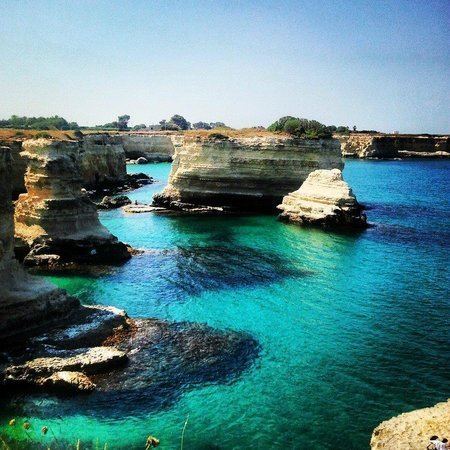Comuni 97 Postal code 73001-73100 Area 2,759 km² | Time zone CET (UTC+1) Telephone prefix 0832, 0833, 0836 Population 814,495 (2012) | |
 | ||
Points of interest Basilica di Santa Croce, Lecce Cathedral, Samsara Beach, Lido Punta della Suina, Grotta Zinzulusa Destinations | ||
The Province of Lecce (Italian: Provincia di Lecce) is a province in the Apulia region of Italy. Its capital is the city of Lecce which is known as the Florence of the South. The province itself is called the "Heel of Italy". Totally included in the Salento peninsula, it is the second most populous province in Apulia and the twenty-first most populous in Italy.
Contents
Map of Province of Lecce, Italy
It has an area of 2,759 square kilometres (1,065 sq mi) and a total population of 814,495 (2012). There are 97 comunes (Italian: comuni) in the province. It is surrounded by the provinces of Taranto and Brindsi in the northwest, Ionian Sea in the west, Adriatic Sea in the east. This location has established it as a popular tourist destination. It has been ruled by the Romans, Byzantine Greeks, Carolingians, Lombards, Arabs and Normans. The important towns are Lecce, Gallipoli, Nardò, Maglie and Otranto. The important agricultural products are wheat and corn.
History
The province of Lecce has its origins in the ancient Giustizierato, then the Province of Terra d'Otranto. Since the eleventh century the Terra d'Otranto included the territories of the provinces of Lecce, Taranto and Brindisi (with the exception of Fasano and Cisternino). During this time the current region of Lecce was severely affected by poverty despite the production of olive oil. People from Lecce migrated to the Province of Bari where they worked in the wine industry in order to earn their living. Up to 1663 the Province of Terra d'Otranto also included the territory of Matera (Basilicata). Its capital was at first Otranto, but in the Norman period (twelfth century), Lecce was made the capital. After the unification of Italy, the name of Terra d'Otranto was changed to Province of Lecce and its territory was divided into the four districts of Lecce, Gallipoli, Brindisi and Taranto. Its break-up began in 1923, when the district of Taranto was transformed into the new province of the Ionian. After the first world war the economic condition worsened and unemployment reached its height. These factors coupled with the negligence of the weak government prompted the farm workers to revolt against their farm owners. After being captured the farm owners were paraded in public places. During the medieval era, Muslim slaves were transported from the ports located in the province and the practice of keeping slaves was common. Lecce stone extracted from the province has been used in decorating several historical monuments and is widely used in interior decoration.
Natural Reserve of San Cataldo is located in the province. Lakes Alimini Grande and Alimini Piccolo are also located in the province. Italian and Griko language are spoken by the inhabitants. A few major attractions of the province are Piazza Duomo, Piazza Sant'Oronzo, Palazzo del Seggio, Church of Santa Maria delle Grazie, Castle of Charles V, Basilica di Santa Croce, Porto Cesareo, Gallipoli and Torre San Giovanni. The Natural Park of Porto Selvaggio is known for its caves.
Communes
Lecce has several ethnic and linguistic minority groups. A Griko community of around 40,000 lives in the Grecia Salentina region in the central area of the province, with an Arbëreshe community in Soleto.
